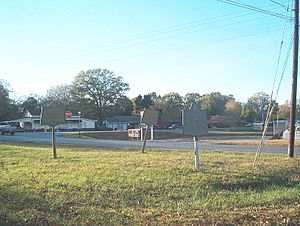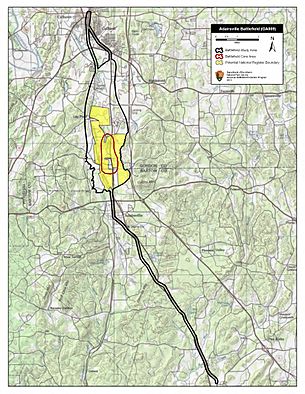Battle of Adairsville facts for kids
Quick facts for kids Battle of Adairsville |
|||||||
|---|---|---|---|---|---|---|---|
| Part of the American Civil War | |||||||
 Three marker signs in Adairsville Cemetery, site of part of the battlefield, describe the battle |
|||||||
|
|||||||
| Belligerents | |||||||
| Commanders and leaders | |||||||
| William T. Sherman | Joseph E. Johnston | ||||||
| Units involved | |||||||
| Military Division of the Mississippi | Army of Tennessee | ||||||
| Strength | |||||||
| 4,174 | 4,477 | ||||||
| Casualties and losses | |||||||
| 200 | Unknown | ||||||
The Battle of Adairsville was a short but important fight during the American Civil War. It happened on May 17, 1864, near Adairsville, Georgia. This battle was part of the larger Atlanta Campaign.
Confederate General Joseph E. Johnston used this battle to slow down the Union army. His goal was to set a trap for them later at Cassville.
Contents
Why the Battle Happened
The Armies on the Move
After the Battle of Resaca, General Johnston's Confederate army began to retreat. They were moving south, away from the Union forces. Major General William Tecumseh Sherman and his Union army were right behind them.
Johnston was looking for a good place to defend. He wanted to stop Sherman's advance towards Atlanta. But he couldn't find a strong defensive spot near Calhoun, Georgia. So, he kept moving his army south towards Adairsville.
Confederate Cavalry's Role
As Johnston's main army retreated, his cavalry (soldiers on horseback) played a key role. They fought bravely at the back of the army. This "rearguard action" helped keep Sherman's troops from getting too close. It bought Johnston more time to find a better position.
The Battle Unfolds
Searching for a Stronghold
After crossing the Oostanaula River, General Johnston hoped to make a stand. He wanted to force the Union army to attack him in a difficult spot. He thought the area near Calhoun would be good.
However, the land wasn't suitable for a strong defense. So, during the night of May 16–17, Johnston led his Confederate troops further south. They headed towards Adairsville.
Sherman's Pursuit
General Sherman continued to chase Johnston's army. He split his forces into three groups. They advanced on a wide front, covering a large area. There were small fights and skirmishes along the way. But the main parts of the armies didn't clash much at first.
First Contact at Adairsville
About two miles north of Adairsville, Union soldiers met Confederate troops. These were from William J. Hardee's Confederate corps. Union Major General Oliver Otis Howard and his IV Corps began to skirmish with them.
Some Union regiments, like the 44th Illinois and 24th Wisconsin, attacked. They were led by Major Arthur MacArthur, Jr.. He was the father of the famous General Douglas MacArthur. These Union soldiers faced strong resistance and suffered losses. General George Henry Thomas then called off further attacks.
Johnston's Clever Plan
Johnston still couldn't find a good defensive spot at Adairsville. So, he had to keep retreating. But as he pulled back, he came up with a smart plan. He noticed there were two roads leading south from Adairsville. One went to Kingston, and the other to Cassville.
Johnston guessed that Sherman would split his army to use both roads. This would give Johnston a chance to attack one part of Sherman's army. He could hit one column before the other could arrive to help.
The Trap at Cassville
Dividing the Armies
On the night of May 17–18, the Confederates left Adairsville. Johnston sent William J. Hardee's Corps towards Kingston. He took the rest of his army towards Cassville.
Johnston hoped Sherman would think most of the Confederates were in Kingston. If Sherman sent most of his forces there, Hardee would hold them off. Meanwhile, Johnston, with Generals Leonidas Polk and John Bell Hood, would attack the smaller Union group at Cassville.
Sherman's Reaction
Sherman reacted just as Johnston had hoped. He sent James B. McPherson and most of George Henry Thomas's army towards Kingston. He sent only John Schofield and one corps of Thomas's army down the road to Cassville.
The Plan Goes Wrong
On the morning of May 19, Johnston ordered Hood to move. Hood was supposed to march along a country road east of the Adairsville-Cassville Road. He would then form his corps to face west. The idea was that Polk would attack the front of the Union column. Then, Hood would attack its left side.
But as Hood moved into position, he unexpectedly ran into a Union brigade. This was Daniel Butterfield's brigade, and they were to the east. This was very dangerous for Hood. If he had formed his troops facing west, these Union soldiers could have attacked his exposed side and rear.
After a short fight, Hood pulled back to rejoin Polk. Johnston believed his chance for a successful battle had passed. He ordered Hood and Polk to move to a new defensive line. This line was east and south of Cassville. Hardee's corps, which had been pushed out of Kingston, also joined them there.
Johnston positioned his army on a ridge. He hoped Sherman would attack them there on May 20. Johnston was confident his troops could push back the enemy.
The Retreat Continues
During the night, the Confederates again withdrew. They crossed the Etowah River. The soldiers had mixed feelings. They had lost strong positions at Dalton and had retreated from Resaca, Calhoun, and Adairsville. Now they were retreating again in the dark.
Earlier that morning, they had been ready for battle and felt hopeful. Now, their disappointment was strong. While their spirits would improve later, many Southern soldiers lost some trust in Johnston's leadership after these retreats.


